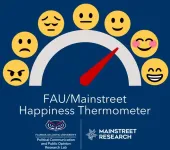(Press-News.org) Jonathan Chen, MD, PhD, an investigator in the department of Pathology at Massachusetts General Hospital and Nir Hacohen, PhD, director of the Center of Cancer Immunology at Massachusetts General Hospital, are co-authors of a recently published study in Nature Immunology, Human Lung Cancer Harbors Spatially-organized Stem-immunity Hubs Associated with Response to Immunotherapy.
What Question Were You Investigating?
Multicellular networks are critical in mediating immune responses. How do immune cells organize within tumors to effectively eliminate malignant cells?
We recently reported the discovery of a network of immune cells found in colorectal cancer. We termed these networks “immunity hubs,” and they are characterized as foci of activated T cells abutting tumor and immune myeloid cells expressing T cell-attracting molecules.
This finding suggests the existence of a positive feedback loop in which activated T cells drive further T cell recruitment by local cells in the tumor.
We reasoned that immunity hubs might be predictive of response to immunotherapy because they were enriched in a class of colorectal tumors known to have higher rate of response to PD-1 blockade immunotherapy.
However, while our study of colorectal samples includes this class of tumors, the patients in our study were not treated with immunotherapy.
In this new study, we sought to answer whether immunity hubs are indeed predictive of response to standard of care immunotherapy.
We studied non-small cell lung cancer (NSCLC), which is commonly treated with PD-1 blockade immunotherapy and is the leading cause of cancer death worldwide.
What Methods or Approach Did You Use?
We first used a focused approach to image key transcripts and proteins of the hubs to detect immunity hubs in a cohort of 68 lung cancer patients, allowing us to discover a new variant of the immunity hub, which we termed the “stem-immunity hub.”
We then developed a less biased approach to image 479 transcripts that represent many cell types and gene programs in the tumor microenvironment to better understand the composition of these hubs and their interactions with other cells in the tumor.
This high-resolution spatial approach allowed us to discover important cell-cell interactions that may regulate the formation and function of these hubs.
What Did You Find?
We found that patients without immunity hubs in their tumors prior to PD-1 blockade therapy had poor outcomes relative to patients with hubs.
Critically, we discovered the stem-immunity hub, a subtype of immunity hub that is strongly associated with favorable immunotherapy response.
Stem-immunity hubs were enriched for a type of T cell remarkable for its ability to divide and invigorate the antitumor immune response after PD-1 blockade. So, the finding of these stem-immunity hubs represents a new way to think about how the immune response is organized in human cancer.
What are the Implications?
The most obvious implication of our work is that we can use the presence of the immunity hub, particularly the stem-immunity hub subclass, as a biomarker to predict response to immunotherapy.
The current standard biomarker for prediction of immunotherapy response is PD-L1 antibody staining, but it can be inaccurate and difficult to use.
We are currently testing a simple two marker tissue stain that reflects immunity and can be assessed by pathologists using a standard workflow.
We think the immunity hub may be how the immune system organizes to fight tumors.
Therefore, we aim to develop therapeutics based on findings in this study to augment immunity hubs and support the anti-tumor immune response.
What are the Next Steps?
As stated above, we are testing a simple two-color slide stain for stem-immunity hubs that may be clinically useful for guiding treatment decisions.
Additionally, we hypothesize that stem-immunity hubs may be sites where stem-like T cells are nurtured and could serve as platforms for launching a durable anti-tumor response.
We are currently testing the role of stem-immunity hubs in mouse models to determine if they induce greater and more durable anti-tumor immune response.
Paper cited:
Chen, J.H., Nieman, L.T., Spurrell, M. et al. Human lung cancer harbors spatially organized stem-immunity hubs associated with response to immunotherapy. Nat Immunol (2024). https://doi.org/10.1038/s41590-024-01792-2
About the Massachusetts General Hospital
Massachusetts General Hospital, founded in 1811, is the original and largest teaching hospital of Harvard Medical School. The Mass General Research Institute conducts the largest hospital-based research program in the nation, with annual research operations of more than $1 billion and comprises more than 9,500 researchers working across more than 30 institutes, centers and departments. In July 2022, Mass General was named #8 in the U.S. News & World Report list of "America’s Best Hospitals." MGH is a founding member of the Mass General Brigham healthcare system.
END
Research spotlight: Stem-immunity hubs associated with response to immunotherapy
2024-03-19
ELSE PRESS RELEASES FROM THIS DATE:
Immunotherapy targeting cancer fusion protein may hold key to treating rare liver cancer
2024-03-19
(MEMPHIS, Tenn. – March 19, 2024) Fibrolamellar carcinoma (FLC) is a rare liver cancer with a poor prognosis if not addressed early with surgery. The disease is caused by a single genetic mutation that creates a fusion protein. Scientists at St. Jude Children’s Research Hospital and The University of Tennessee Health Science Center discovered an immune cell protein that can target and spark the destruction of FLC. Scientists found naturally occurring T cells in a patient with FLC were uniquely capable of recognizing the fusion protein. These cells provide ...
Experts say low-carb diets are backed by science and support health equity
2024-03-19
What was once a subject of public health debate is now a matter of clear scientific consensus: low-carb diets can be safe, nutritious, and should be included as an option within the Dietary Guidelines for Americans. A group of experts, including leading nutrition and health researchers and healthcare professionals, reviewed the evidence and arrived at more than 15 areas of unanimous scientific agreement on the benefits, opportunities and considerations around lower carbohydrate dietary patterns.
A review of the state of science and summary of the consensus ...
From the Mediterranean into the Atlantic: The Gibraltar arc is migrating to the west
2024-03-19
Oceans are subject to continuous change, mostly over extremely vast periods of time running into millions of years. Researchers from Universidade de Lisboa in Portugal and Johannes Gutenberg University Mainz (JGU) in Germany now used computer simulations to demonstrate that a subduction zone originating in the Western Mediterranean will propagate into the Atlantic under the Strait of Gibraltar. According to their model, this will create a new Atlantic subduction zone 50 million years into the future, which will then move down into the Earth's mantle. The new geodynamic ...
The science is in: Being good is actually good for you
2024-03-19
“A wonderful book full of fascinating scientific insights explained with great clarity, inspiring us to let kindness reign in our hearts and thus accomplish the twofold benefit of others and oneself.” —Matthieu Ricard, author of Altruism: The Power of Compassion to Transform Ourselves and the World
The science is in: being good is actually good for you. In this bracingly original book, The Biology of Kindness—the first in a trilogy on the topic of daily wellness—the science of mindfulness and the findings of biology come together to show how kindness and optimism improve ...
Enhanced stability of tristetraprolin promotes bone health and reduces frailty
2024-03-19
Alexandria, VA, USA – A study aiming to use a novel transgenic mouse model (TTP knock-in – TTPKI) that has a moderate elevation of TTP systemically to understand if there is a long-term benefit for bone health, thus contributing towards healthy aging was presented at the 102nd General Session of the IADR, which was held in conjunction with the 53rd Annual Meeting of the American Association for Dental, Oral, and Craniofacial Research and the 48th Annual Meeting of the Canadian Association for Dental Research, on March 13-16, 2024, in New Orleans, ...
Happiness poll: Democrats and Diden voters report more happiness than GOP and Trump supporters
2024-03-19
Voters of the Democratic party and U.S. President Joe Biden are happier than voters for the Republican party and former U.S. President Donald Trump, while older and wealthier adult voters are happier than younger and less-wealthy ones, according to a new Florida Atlantic University PolCom and Mainstreet Research happiness poll released today in advance of the United Nation’s International Day of Happiness on March 20.
“Happiness is important to understand as it influences the well-being and satisfaction of citizens, which in turn shapes their voting behavior,” said Carol Bishop Mills, Ph.D., FAU’s communication professor, PolCom co-director, and expert in relational ...
Mass General Brigham researchers develop AI foundation models to advance pathology
2024-03-19
Foundation models, advanced artificial intelligence systems trained on large-scale datasets, hold the potential to provide unprecedented advancements for the medical field. In computational pathology (CPath), these models may excel in diagnostic accuracy, prognostic insights, and predicting therapeutic responses. Researchers at Mass General Brigham have designed the two of the largest CPath foundation models to date: UNI and CONCH. These foundation models were adapted to over 30 clinical, diagnostic needs, including ...
Colorectal cancer screening in Araba (Basque Country)
2024-03-19
Background and objectives
Colorectal cancer (CRC) is the third most common malignancy worldwide. The average age at diagnosis of CRC is around 70 years old. This study aimed to assess the prevalence of asymptomatic CRC and premalignant lesions in the colon in OSI Araba.
Methods
This study included individuals aged 50–69 who were admitted to OSI Araba Health Centers. It spanned from the start of CRC screening through fecal occult blood test immunological analysis in 2009 to the publication of the latest updated data in 2021.
Results
An average of 90.98% of participants obtained a definitive result. Specifically, ...
Primary care telemedicine linked with fewer antibiotics for children than direct-to-consumer telemedicine
2024-03-19
New research from the University of Pittsburgh and UPMC shows that telemedicine visits conducted for children with primary care providers (PCPs) are associated with fewer antibiotic prescriptions than telemedicine visits with virtual-only direct-to-consumer (DTC) companies.
The findings, published in JAMA Network Open, highlight the importance of supporting integrated telemedicine within the primary care setting and the potential challenges and limitations of delivering virtual-only acute care to children.
“Respiratory tract infections are one of the most common reasons that kids receive antibiotics, ...
CABI-led study shows benefits of chatgroups to human health can be replicated in plant health
2024-03-19
A CABI-led study has revealed that there is evidence of the benefits of chatgroups to human health which can also be replicated in plant health.
The research analysed the opportunities and pitfalls of using chatgroups for plant health systems and examined the conditions for strengthening chatroom functions. It also considered the possibility of replicating reported successes in healthcare settings to plant health systems.
The scientists from CABI, who were joined by colleagues including from the Knowledge, Technology and ...






